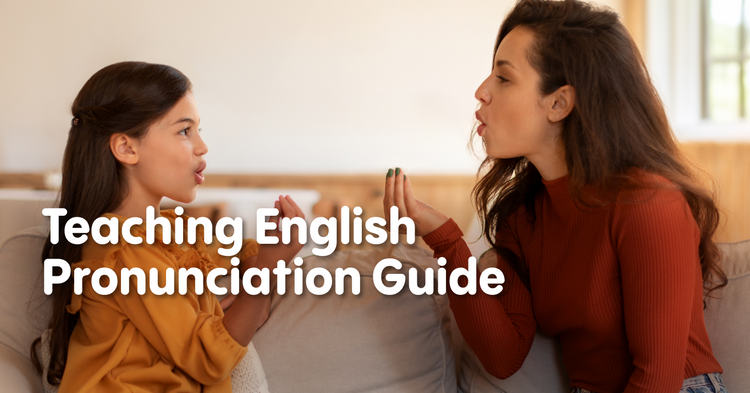Teaching English pronunciation to kids aged 3 to 14 involves a distinct approach tailored to their age, cognitive development, and linguistic abilities. AllRight.com has prepared the guide for ESL teachers to help teach pronunciation to kids. This definitive guide provides comprehensive strategies and techniques to assist educators in effectively teaching English pronunciation to young learners within this age range.
Objectives of Teaching Young Learners
Foster Early Language Acquisition: The primary goal is to expose young learners to the English language early, creating a foundation for future language proficiency.
Enhance Listening Skills: Develop strong listening skills to aid in sound discrimination and accurate pronunciation.
Build Vocabulary: Introduce age-appropriate vocabulary, ensuring children can recognize, pronounce, and use words effectively in context.
Encourage Oral Communication: Motivate young learners to confidently express themselves in English, using correct pronunciation and intonation.
Lay the Groundwork for Reading and Writing: Establish a phonetic base that will facilitate reading and writing as children progress in their language learning journey.
Understanding the Unique Needs of Young Learners
1. Phonetic Awareness
Introduce young learners to basic phonetic sounds in an engaging and playful manner, laying the foundation for phonemic awareness. Recommend reading:
2. Visual Aids and Storytelling
Utilize colorful visual aids and storytelling to associate sounds with objects or characters, making phonetic learning enjoyable and memorable for young children.
3. Songs and Rhymes
Incorporate songs, rhymes, and chants with clear pronunciation to help children develop an ear for English sounds and rhythm. There are a lot of different YouTube videos that teachers can you during the ESL lesson.
4. Interactive Games and Online Tools
Design interactive games that focus on specific phonemes, encouraging children to participate actively while learning correct pronunciation.
The best way is to use interactive tools that help your students get engaged in the process of learning. They can be adoptable.
Adapting Teaching for Different Age Groups
1. Preschool (Ages 3-5)
Focus on basic sounds, rhymes, and phonemic awareness through games, songs, and interactive storytelling.
Approach:
- Interactive Games: Use games like "Sound Matching" where children match objects with the beginning sound.
- Rhyme Time: Incorporate rhyming games and activities to familiarize children with rhyming words.
- Phonemic Awareness Activities: Engage in activities that emphasize recognizing and producing sounds, such as "Guess the Animal Sound."
- Interactive Storytelling: Tell simple, interactive stories emphasizing the sounds of various animals or objects.
2. Elementary (Ages 6-10)
Introduce phonics, simple word stress patterns, and pronunciation rules through fun activities and games.
Approach:
- Phonics Instruction: Begin with introducing the phonetic sounds of each letter and their combinations (e.g., "th," "sh," "ch").
- Word Stress Games: Engage children in word stress games like "Word Stress Bingo" to identify and stress syllables correctly.
- Pronunciation Rules: Teach pronunciation rules using fun mnemonic devices (e.g., "i before e, except after c").
- Story-Based Learning: Use stories with highlighted phonetic elements to reinforce pronunciation rules and patterns.
3. Pre-Teens (Ages 11-13)
Reinforce phonics and delve into more complex sounds, stress patterns, and basic intonation through engaging exercises and dialogues.
Approach:
- Advanced Phonics: Introduce more complex phonics rules and patterns (e.g., diphthongs, silent letters) and their impact on pronunciation.
- Sound Discrimination Activities: Engage in activities like "Odd One Out" where students identify words with different phonemes.
- Basic Intonation: Introduce rising and falling intonation through sentence exercises and dialogues.
4. Early Teens (Ages 14)
Build on previous knowledge, incorporating word stress, intonation, and connected speech, using relatable themes and discussions.
Approach:
- Word Stress and Intonation Practice: Use sentence drills and role-play exercises to emphasize proper word stress and intonation in different contexts.
- Connected Speech Awareness: Introduce connected speech elements like linking, assimilation, and elision through interactive exercises and discussions.
- Real-life Scenarios: Engage students in discussing relevant and relatable topics, focusing on correct pronunciation, stress, and intonation.
Teaching Vowels and Consonants to Young Learners
Teaching vowels and consonants is a fundamental step in helping young learners understand the building blocks of the English language.
Understanding Vowels and Consonants
Vowels: Vowels are speech sounds produced with an open vocal tract. They form the core of a syllable and are typically pronounced without any obstruction in the mouth. In English, there are five primary vowels: A, E, I, O, and U.
Consonants: Consonants are speech sounds that involve some degree of constriction or closure in the vocal tract. They play a crucial role in forming syllables and are often combined with vowels to create meaningful sounds. Examples of consonants in English include B, C, D, F, G, H, J, K, L, M, N, P, Q, R, S, T, V, W, X, Y, and Z.
Teaching Vowels
1. Introduction with Visual Aids:
Introduce each vowel using vibrant visual aids such as flashcards or drawings that associate the vowel with a recognizable image.
| Vowel | Example Word | Image Representation |
|---|---|---|
| A | Apple | Image of an apple |
| E | Elephant | Image of an elephant |
| I | Ice Cream | Image of an ice cream cone |
| O | Octopus | Image of an octopus |
| U | Umbrella | Image of an umbrella |
Teaching Vowels and Consonants to Young Learners
Teaching vowels and consonants is a fundamental step in helping young learners understand the building blocks of the English language. This guide provides effective strategies, examples, and tables to facilitate teaching vowels and consonants to kids aged 3 to 14.
Understanding Vowels and Consonants
Vowels: Vowels are speech sounds produced with an open vocal tract. They form the core of a syllable and are typically pronounced without any obstruction in the mouth. In English, there are five primary vowels: A, E, I, O, and U.
Consonants: Consonants are speech sounds that involve some degree of constriction or closure in the vocal tract. They play a crucial role in forming syllables and are often combined with vowels to create meaningful sounds. Examples of consonants in English include B, C, D, F, G, H, J, K, L, M, N, P, Q, R, S, T, V, W, X, Y, and Z.
Teaching Vowels
1. Introduction with Visual Aids:
Introduce each vowel using vibrant visual aids such as flashcards or drawings that associate the vowel with a recognizable image.
| Vowel | Example Word | Image Representation |
|---|---|---|
| A | Apple | Image of an apple |
| E | Elephant | Image of an elephant |
| I | Ice Cream | Image of an ice cream cone |
| O | Octopus | Image of an octopus |
| U | Umbrella | Image of an umbrella |
2. Vowel Sounds:
Explain the unique sounds associated with each vowel using simple words as examples:
- A (as in "cat")
- E (as in "bed")
- I (as in "sit")
- O (as in "dog")
- U (as in "bug")
3. Vowel Recognition:
Conduct activities where young learners identify vowels in various words, distinguishing them from consonants.
4. Vowel Songs and Rhymes:
Incorporate songs or rhymes that emphasize vowel sounds, making the learning process enjoyable.
Teaching Consonants
1. Introduction with Visual Aids:
Introduce each consonant using visual aids like flashcards or drawings associated with recognizable words.
| Consonant | Example Word | Image Representation |
|---|---|---|
| B | Ball | Image of a ball |
| C | Cat | Image of a cat |
| D | Dog | Image of a dog |
| F | Fish | Image of a fish |
| ... | ... | ... |
2. Consonant Sounds:
Explain the unique sounds associated with each consonant using simple words as examples:
- B (as in "ball")
- C (as in "cat")
- D (as in "dog")
- F (as in "fish")
- ...
3. Consonant Recognition:
Conduct activities where young learners identify consonants in various words, distinguishing them from vowels.
4. Consonant Games:
Incorporate interactive games like "Consonant Bingo" where children match consonants to corresponding images or words.
Conclusion
Teaching English pronunciation to kids aged 3 to 14 is a fundamental step towards effective communication and language growth. This definitive guide emphasized the importance of understanding young learners' unique needs and showcased diverse strategies, from playful phonemic awareness activities for preschoolers to nuanced word stress and intonation exercises for early teens.
The use of interactive games, visual aids, storytelling, and phonics instruction tailored to different age groups ensures engaging and effective learning. A focus on correct pronunciation, word stress, intonation, and connected speech equips young learners with essential language skills.
By adopting these approaches, educators can instill a strong foundation in English pronunciation, empowering young learners to express themselves clearly and confidently during the ESL class. As they progress in their language journey, the skills acquired will significantly contribute to their overall language proficiency and communication competence.









